| Listing 1 - 6 of 6 |
Sort by
|
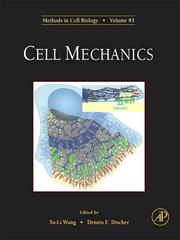
ISBN: 9780123705006 0123705002 Year: 2007 Publisher: Amsterdam : Elsevier,
Abstract | Keywords | Export | Availability | Bookmark
 Loading...
Loading...Choose an application
- Reference Manager
- EndNote
- RefWorks (Direct export to RefWorks)
Cell mechanics is the field of study that looks at how cells detect, modify, and respond to the physical properties of the cell environment. Cells communicate with each other through chemical and physical signals which are involved in a range of process from embryogenesis and wound healing to pathological conditions such as cancerous invasion. Similar principles are also likely to be critical for success in regenerative medicine. Cell mechanics is thus central to understanding these principles. As cell mechanics draws from the fields of biology, chemistry, physics, engineering, and mathematics, this book aims not only to provide a collection of research methods, but also to develop a common language among scientists who share the interest in cell mechanics but enter the field with diverse backgrounds. To this end all of the contributing authors have sought to explain in plain language the nature of the biological problems, the rationale for the approaches, in addition to the methods themselves. In addition, to balance practical utility against conceptual advances, the book has intentionally included both chapters that provide detailed recipes and those that emphasize basic principles. * Presents a distinctive emphasis on matrix mechanics and their interplay with cell functions * Includes highly significant topics relevant to basic and translational research, as well as tissue engineering * Emphasizes mechanical input and output of cells
Cells --- Biomechanics. --- Cellular Structures. --- Mechanotransduction, Cellular. --- Mechanical properties.
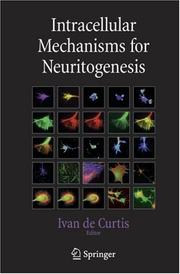
ISBN: 1489990224 038733128X 9786610816583 1280816589 0387685618 Year: 2007 Publisher: New York : Springer,
Abstract | Keywords | Export | Availability | Bookmark
 Loading...
Loading...Choose an application
- Reference Manager
- EndNote
- RefWorks (Direct export to RefWorks)
A major issue of modern neurobiology is to understand how neurons extend their neurites to form a functional network. While a large amount of information is available on the extracellular mechanisms driving neuritogenesis, the study of the intricate molecular machinery underlying the intracellular mechanisms has only recently been addressed. The purpose of this book is to present novel, distinct, but highly related aspects of the intracellular mechanisms required for the formation of a functional neurite, which include cytoskeletal organization, membrane traffic, and signal transduction. In particular, the proposed authors would address the importance of the integration among distinct aspects of the cell biology of developing neurons involved in neurite extension. The aim of the book is to present this topic to the general readership of neurobiologists and molecular and cellular biologists to further stimulate the interest into this exciting section of neurobiology. Moreover, the book could represent a reference for researchers directly involved in the study of neuronal development, and a textbook for PhD courses in molecular neurobiology The authors contributing to this book are all internationally recognized leaders in their respective fields of research, and the work from their laboratories embodies state of the art approaches to address this fundamental aspect of molecular neurobiology.
Axons. --- Dendrites. --- Molecular neurobiology. --- Nerve Growth Factors. --- Neurons. --- Neurons --- Axons --- Dendrites --- Molecular neurobiology --- Cell Surface Extensions --- Nerve Fibers --- Cells --- Nervous System --- Cellular Structures --- Anatomy --- Growth Cones --- Neurites --- Medicine --- Human Anatomy & Physiology --- Health & Biological Sciences --- Neuroscience --- Neurology --- Growth --- Growth. --- Molecular neurology --- Nervous system --- Nerve axons --- Molecular aspects --- Medicine. --- Neurosciences. --- Biomedicine. --- Molecular biology --- Neurobiology --- Neurotrophic functions --- Neural sciences --- Neurological sciences --- Medical sciences
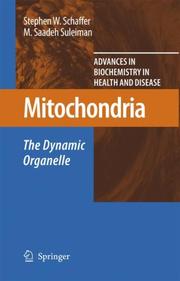
ISBN: 9780387699455 0387699449 9780387699448 1441924183 9786612823237 0387699457 128282323X Year: 2007 Publisher: New York : Springer,
Abstract | Keywords | Export | Availability | Bookmark
 Loading...
Loading...Choose an application
- Reference Manager
- EndNote
- RefWorks (Direct export to RefWorks)
About the Series: Advances in Biochemistry in Heath and Disease presents state-of-the-art discussions in cutting-edge biochemical research, offering exciting developments that impact healthcare and disease research. Volumes in the series focus on cross-disciplinary biomedical research and examine various topics in biochemistry, cell biology, molecular biology, and biomedicine. Mitochondria: The Dynamic Organelle Mitochondria: The Dynamic Organelle focuses on the function of the mitochondria and the organelle’s role in cellular pathology. While the traditional function of the mitochondria is metabolic, recent cutting-edge studies have uncovered a central role for mitochondria in cell signaling, cell survival and cell death. Mitochondria: The Dynamic Organelle presents examples of crosstalk between the mitochondria and the rest of the cell, which serve a regulatory role by modulating the levels of key metabolites, ions and oxidants or the activities of key rate-controlling enzymes. Detailed descriptions of the involvement of membrane receptors, channels, enzymes and metabolites in the cardioprotective mechanisms of the mitochondria are provided. This volume also discusses the death pathways that are initiated by the mitochondria. Novel therapeutic interventions are proposed which interfere with the death cascades, thereby rescuing the cell from mitochondria-linked apoptosis and necrotic oncosis. Mitochondria: The Dynamic Organelle is a timely contribution that addresses the reemergence of the mitochondria as a key player in cellular function and pathology. Key topics: Amino acid metabolism Carbohydrate and lipid metabolism Citric acid cycle regulation and metabolite transport Electron transport and oxidative phosphorylation Ischemic preconditioning Mitochondrial apoptosis Mitochondrial DNA damage Mitochondrial permeability transition Mitochondrial ion transporters Necrotic oncosis and mitochondrial dysfunction Peroxisome proliferators-activated receptors (PPARs) Mitochondria: The Dynamic Organelle is essential reading for researchers, molecular and cellular biologists, biochemists, physiologists and pathologists. About the Editors: Stephen W. Schaffer has been a professor of Pharmacology at the University of South Alabama, College of Medicine since 1988. He received training in mitochondrial function from the Johnson Research Foundation at the University of Pennsylvania. His research focuses on the effects of diabetes and angiotensin II on the heart, with a particular emphasis on the effects of mitochondrial DNA damage on the cardiomyocyte. He is a recipient of the Vincenzo Penagia Distinguished Scientist Award and is a fellow of the International Academy of Cardiovascular Sciences. He serves on the editorial board of Amino Acids and Molecular and Cellular Biochemistry and is editor of several books. M.-Saadeh Suleiman is currently a Professor of Cardiac Physiology at the Faculty of Medicine and Dentistry, University of Bristol. He joined the Department of Physiology in Bristol in 1988 and was one of the founders of the Bristol Heart Institute. His research is focused on myocardial protection including the role of mitochondria, and had significant impact on cardiac surgery where he was a member of the team that received the UK Hospital Doctor Award in 2005 for innovative surgery. He was a recipient of a Fulbright Fellowship and in 2003 was awarded a DSc in Physiology from the University of Bristol. He was elected twice to the executive committee of the British Society of Cardiovascular Research (1998-2004).
Life Sciences. --- Biochemistry, general. --- Molecular Medicine. --- Cell Biology. --- Developmental Biology. --- Life sciences. --- Medicine. --- Biochemistry. --- Cytology. --- Developmental biology. --- Sciences de la vie --- Médecine --- Biochimie --- Cytologie --- Biologie du développement --- Mitochondria. --- Mitochondrial pathology. --- Mitochondria --- Mitochondrial pathology --- Cell Death --- Cell Physiological Processes --- Subcellular Fractions --- Organelles --- Cytoplasmic Structures --- Cell Physiological Phenomena --- Cellular Structures --- Cytoplasm --- Phenomena and Processes --- Cells --- Anatomy --- Intracellular Space --- Biochemistry --- Biology - General --- Cytology --- Biology --- Chemistry --- Health & Biological Sciences --- Physical Sciences & Mathematics --- Mitochondrial disorders --- Chondriosomes --- Diseases --- Pathology --- Molecular biology. --- Cell biology. --- Metabolism --- Pathology, Cellular --- Cell organelles --- Protoplasm --- Disorders --- Development (Biology) --- Growth --- Ontogeny --- Clinical sciences --- Medical profession --- Human biology --- Life sciences --- Medical sciences --- Physicians --- Biological chemistry --- Chemical composition of organisms --- Organisms --- Physiological chemistry --- Cell biology --- Cellular biology --- Cytologists --- Composition --- Health Workforce --- Molecular biochemistry --- Molecular biophysics --- Biophysics --- Biomolecules --- Systems biology --- Medicine --- Biomedical Research. --- Developmental Biology and Stem Cells. --- Research. --- Biological research --- Biomedical research
Book
ISBN: 9783540753759 3540753753 3642094600 3540753761 Year: 2007 Publisher: Berlin : Springer,
Abstract | Keywords | Export | Availability | Bookmark
 Loading...
Loading...Choose an application
- Reference Manager
- EndNote
- RefWorks (Direct export to RefWorks)
The past two decades have witnessed an enormous progress in our understanding of plastid (chloroplast) biology. Basic principles of plastid biogenesis, genome structure and function, gene expression and its regulation as well as plastid-nuclear interaction and communication pathways have been elucidated. In addition, the possibility to directly alter the genetic information of the plastid by transformation has facilitated the study of virtually all aspects of plastid biology in vivo and, moreover, has paved the way to diverse applications of transgenic plastids in biotechnology. The present book provides a comprehensive overview of our current knowledge on plastid biogenesis, plastid-nuclear communication, the regulation of plastid gene expression at all levels, and also assesses the state of the art in key technologies, such as proteomics and chloroplast transformation. Written by recognized experts in the field, it covers plastid differentiation and division, genome structure and function, plastid inheritance, recombination, DNA replication and repair, transcription, RNA processing and translation as well as crucial posttranslational processes in plastid biogenesis and function, including protein processing, the assembly of multiprotein complexes, protein stability and degradation, protein import and sorting.
Genetic recombination --- Plastids --- Plant molecular biology --- Recombinaison génétique --- Plastes --- Biologie moléculaire végétale --- Plant molecular biology. --- Plant Proteins -- Genetics. --- Plastids -- Genetics. --- Plastids -- Metabolism. --- Plastids. --- Recombination, Genetic. --- Gene Expression Regulation, Plant --- Genetics --- Metabolism --- Plant Proteins --- Recombination, Genetic --- Proteins --- Organelles --- Biology --- Metabolic Phenomena --- Gene Expression Regulation --- Genetic Processes --- Genetic Phenomena --- Phenomena and Processes --- Biological Science Disciplines --- Cytoplasmic Structures --- Amino Acids, Peptides, and Proteins --- Natural Science Disciplines --- Cytoplasm --- Chemicals and Drugs --- Disciplines and Occupations --- Intracellular Space --- Cellular Structures --- Cells --- Anatomy --- Cytology --- Plant Physiology --- Botany --- Earth & Environmental Sciences --- Health & Biological Sciences --- Molecular phytobiology --- Phytobiology, Molecular --- Life sciences. --- Biotechnology. --- Cell biology. --- Plant genetics. --- Plant physiology. --- Plant breeding. --- Life Sciences. --- Cell Biology. --- Plant Genetics & Genomics. --- Plant Physiology. --- Plant Breeding/Biotechnology. --- Molecular biology --- Cell organelles --- Photoreceptors --- Plant cells and tissues --- Plant pigments --- Cytology. --- Plant Genetics and Genomics. --- Chemical engineering --- Genetic engineering --- Crops --- Agriculture --- Breeding --- Plants --- Physiology --- Cell biology --- Cellular biology --- Cytologists
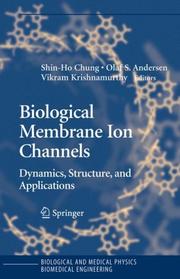
ISBN: 1441922075 0387333231 9786611117986 1281117986 0387689192 Year: 2007 Publisher: New York : Springer,
Abstract | Keywords | Export | Availability | Bookmark
 Loading...
Loading...Choose an application
- Reference Manager
- EndNote
- RefWorks (Direct export to RefWorks)
Ion channels are biological nanotubes that are formed by membrane proteins. Because ion channels regulate all electrical activities in living cells, understanding their mechanisms at a molecular level is a fundamental problem in biology. This book deals with recent breakthroughs in ion-channel research that have been brought about by the combined effort of experimental biophysicists and computational physicists, who together are beginning to unravel the story of these exquisitely designed biomolecules. With chapters by leading experts, the book is aimed at researchers in nanodevices and biosensors, as well as advanced undergraduate and graduate students in biology and the physical sciences. Key Features Presents the latest information on the molecular mechanisms of ion permeation through membrane ion channels Uses schematic diagrams to illustrate important concepts in biophysics Written by leading researchers in the area of ion channel investigations.
Biophysics. --- Ion channels. --- Biology --- Health & Biological Sciences --- Cytology --- Ion channels --- Biophysics --- Metabolism --- Electrophysiological Phenomena --- Membrane Transport Proteins --- Biophysical Phenomena --- Nervous System Physiological Phenomena --- Membrane Glycoproteins --- Cell Physiological Phenomena --- Cellular Structures --- Carrier Proteins --- Physiological Phenomena --- Phenomena and Processes --- Metabolic Phenomena --- Cells --- Membrane Proteins --- Physical Phenomena --- Musculoskeletal and Neural Physiological Phenomena --- Proteins --- Anatomy --- Amino Acids, Peptides, and Proteins --- Chemicals and Drugs --- Cell Membrane --- Membrane Potentials --- Ion Channels --- Cell Membrane Permeability --- Biological Transport --- Biological physics --- Channels, Ion --- Physics. --- Neurosciences. --- Biotechnology. --- Biochemistry. --- Neurobiology. --- Biological physics. --- Biomedical engineering. --- Biophysics and Biological Physics. --- Biomedical Engineering. --- Animal Biochemistry. --- Medical sciences --- Physics --- Clinical engineering --- Medical engineering --- Bioengineering --- Engineering --- Medicine --- Neurosciences --- Biological chemistry --- Chemical composition of organisms --- Organisms --- Physiological chemistry --- Chemistry --- Chemical engineering --- Genetic engineering --- Neural sciences --- Neurological sciences --- Neuroscience --- Nervous system --- Natural philosophy --- Philosophy, Natural --- Physical sciences --- Dynamics --- Composition --- Biological transport, Active --- Ion-permeable membranes --- Membrane proteins --- Biological and Medical Physics, Biophysics. --- Biomedical Engineering and Bioengineering.
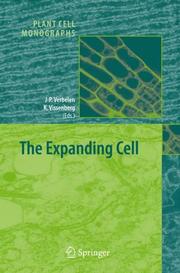
ISBN: 9783540391142 3540391142 3642072550 9786610656707 1280656700 3540391169 Year: 2007 Publisher: Berlin ; New York : Springer,
Abstract | Keywords | Export | Availability | Bookmark
 Loading...
Loading...Choose an application
- Reference Manager
- EndNote
- RefWorks (Direct export to RefWorks)
After division, plant cells are able to increase their volume enormously by cell expansion, making the expanding cell a crucial player in the production of biomass. The study of plant cell expansion involves many different disciplines and technical approaches, and this book is the first attempt to bring this diversity together to present a multifaceted view of the most up-to-date knowledge. Included are data ranging from biophysical measurements and chemical analysis to molecular biological approaches and microscopy.
Plant cells and tissues. --- Cells --- Plantes --- Cellules --- Growth. --- Cellules et tissus --- Croissance --- Cells -- Development. --- Cells -- Growth. --- Plant cells and tissues --- Cell Enlargement --- Cell Wall --- Cell Growth Processes --- Cellular Structures --- Cell Physiological Processes --- Growth --- Growth and Development --- Anatomy --- Cell Physiological Phenomena --- Physiological Processes --- Phenomena and Processes --- Physiological Phenomena --- Cytology --- Plant Physiology --- Botany --- Biology --- Earth & Environmental Sciences --- Health & Biological Sciences --- Cell growth --- Plant tissues --- Life sciences. --- Plant biochemistry. --- Cell biology. --- Plant science. --- Botany. --- Plant anatomy. --- Plant development. --- Plant physiology. --- Microscopy. --- Life Sciences. --- Cell Biology. --- Plant Physiology. --- Plant Sciences. --- Plant Anatomy/Development. --- Plant Biochemistry. --- Biological Microscopy. --- Cell proliferation --- Plant anatomy --- Tissues --- Cytology. --- Biochemistry. --- Plants --- Physiology --- Biological chemistry --- Chemical composition of organisms --- Organisms --- Physiological chemistry --- Chemistry --- Medical sciences --- Plant structure --- Structural botany --- Vegetable anatomy --- Botanical science --- Phytobiology --- Phytography --- Phytology --- Plant biology --- Plant science --- Natural history --- Analysis, Microscopic --- Light microscopy --- Micrographic analysis --- Microscope and microscopy --- Microscopic analysis --- Optical microscopy --- Optics --- Cell biology --- Cellular biology --- Cytologists --- Composition --- Structure --- Phytochemistry --- Plant biochemistry --- Plant chemistry --- Biochemistry --- Phytochemicals --- Plant biochemical genetics --- Development of plants --- Plant development --- Developmental biology --- Growth (Plants) --- Ontogeny --- Floristic botany
| Listing 1 - 6 of 6 |
Sort by
|

 Search
Search Feedback
Feedback About UniCat
About UniCat  Help
Help News
News